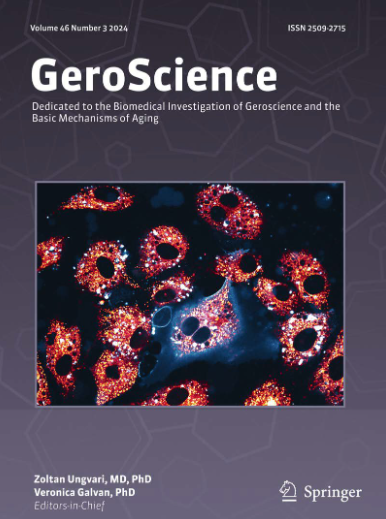A novel synthetic 3,4,5-tri-feruloylquinic acid enhances learning and memory via neurotrophin signaling in an aging model senescence-accelerated prone 8 mice.
IF 5.3
2区 医学
Q1 GERIATRICS & GERONTOLOGY
引用次数: 0
Abstract
This study is the first to investigate the anti-aging effects of the newly synthesized compound, 3,4,5-tri-feruloylquinic acid (TFQA), in vivo using the senescence-accelerated mouse prone 8 (SAMP8) model, through integrated whole-transcriptomic and biochemical analyses. Oral administration of TFQA (1 mg/kg body weight) for 37 days led to significant cognitive improvements, as demonstrated by enhanced performance in the Morris water maze (MWM) test, including reduced escape latency and increased time spent in the target zone, target crossings, distance traveled, and swimming speed. Gene Ontology (GO) analysis of hippocampal microarray data revealed that TFQA upregulated genes associated with neurotransmitter and synaptic functions, while downregulating inflammatory pathways. Protein-protein interaction (PPI) analysis indicated that neurotrophin signaling was a critical upstream regulator in TFQA-treated mice. Further biochemical validation showed elevated levels of neurotransmitters (serotonin, noradrenaline, and dopamine) in the brain. Additionally, mRNA expression of tumor necrosis factor (Tnf), an inflammatory cytokine, was significantly reduced in the brain. Examination of the neurotrophins involved in neurotrophin signaling revealed that TFQA most prominently regulated brain-derived neurotrophic factor (Bdnf) co-expressed genes, which was validated by increased Bdnf expression in both the brain and serum of SAMP8 mice. Bioluminescence imaging demonstrated that a single oral dose of TFQA significantly increased BDNF expression in the brains of BDNF-IRES-AkaLuc mice. Binding studies showed that TFQA has a strong affinity for the tyrosine receptor kinase B (TrkB) receptor. In summary, TFQA holds potential as a neuroprotective agent, mitigating learning and memory deficits in aging mice via neurotrophin signaling, particularly through BDNF upregulation.一种新型合成的3,4,5-三阿魏酰奎宁酸通过神经营养因子信号增强衰老模型加速倾向小鼠的学习和记忆能力。
本研究首次利用衰老加速小鼠易发8 (SAMP8)模型,通过综合全转录组学和生化分析,在体内研究了新合成的化合物3,4,5-三阿魏酰奎宁酸(TFQA)的抗衰老作用。口服TFQA (1 mg/kg体重)37天导致显著的认知改善,如Morris水迷宫(MWM)测试中的表现增强,包括减少逃避潜伏期,增加在靶区度过的时间,穿过靶区,行进距离和游泳速度。基因本体(GO)分析海马微阵列数据显示,TFQA上调与神经递质和突触功能相关的基因,同时下调炎症通路。蛋白-蛋白相互作用(PPI)分析表明,神经营养因子信号是tfqa处理小鼠的关键上游调节因子。进一步的生化验证表明,大脑中的神经递质(血清素、去甲肾上腺素和多巴胺)水平升高。此外,脑内炎症细胞因子肿瘤坏死因子(Tnf)的mRNA表达显著降低。对参与神经营养因子信号传导的神经营养因子的检测显示,TFQA对脑源性神经营养因子(Bdnf)共表达基因的调节最为显著,这一点通过SAMP8小鼠脑和血清中Bdnf表达的增加得到了验证。生物发光成像显示,单次口服TFQA可显著增加BDNF- ires - akaluc小鼠脑内BDNF的表达。结合研究表明,TFQA对酪氨酸受体激酶B (TrkB)受体具有很强的亲和力。总之,TFQA具有作为神经保护剂的潜力,通过神经营养因子信号,特别是通过BDNF上调,减轻衰老小鼠的学习和记忆缺陷。
本文章由计算机程序翻译,如有差异,请以英文原文为准。
求助全文
约1分钟内获得全文
求助全文
来源期刊

GeroScience
Medicine-Complementary and Alternative Medicine
CiteScore
10.50
自引率
5.40%
发文量
182
期刊介绍:
GeroScience is a bi-monthly, international, peer-reviewed journal that publishes articles related to research in the biology of aging and research on biomedical applications that impact aging. The scope of articles to be considered include evolutionary biology, biophysics, genetics, genomics, proteomics, molecular biology, cell biology, biochemistry, endocrinology, immunology, physiology, pharmacology, neuroscience, and psychology.
 求助内容:
求助内容: 应助结果提醒方式:
应助结果提醒方式:


